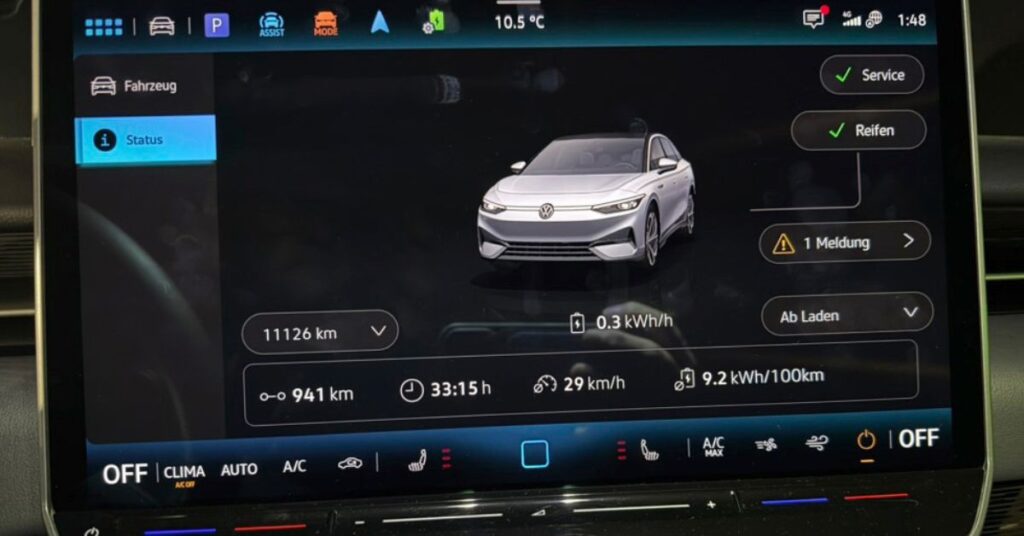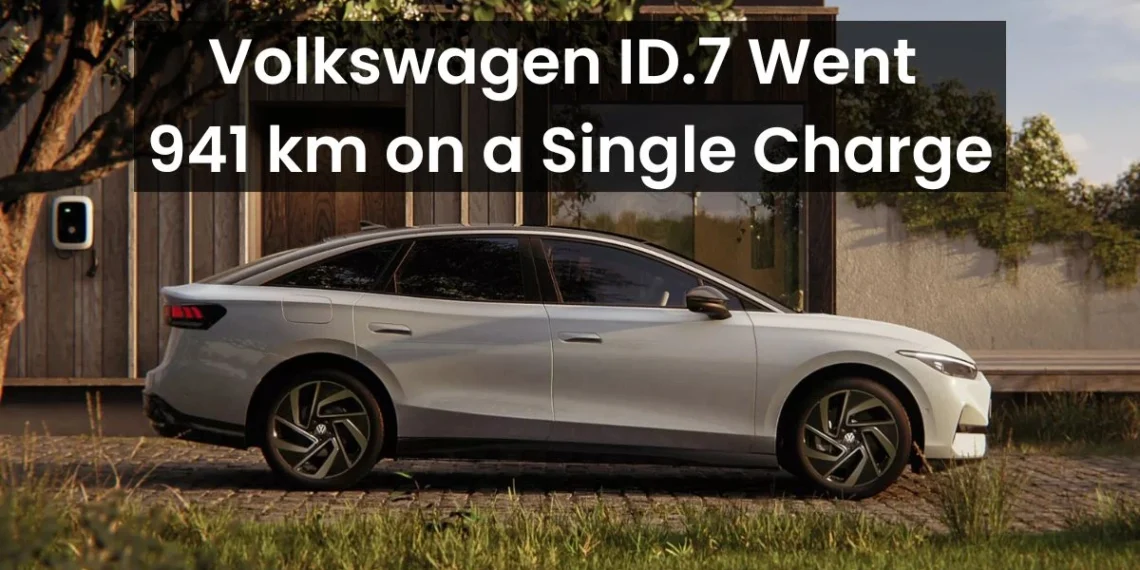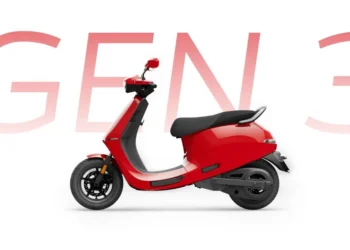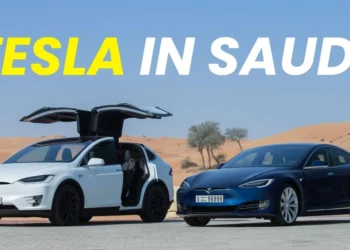Volkswagen’s ID 7 has made a significant achievement in the electric vehicle (EV) world by covering an extraordinary 941 km (585 miles) on a single charge. This milestone exceeds the official WLTP range by an impressive 32.7% and showcases the car’s exceptional efficiency, proving that electric vehicles can be practical for long-distance travel. In this blog, we will explore how the Volkswagen ID 7 achieved such a feat, what makes it so efficient, and how it stacks up against other electric vehicles on the market.
Table of Contents
Volkswagen ID.7 Went 941 km on a Single Charge: The Test Details and Conditions

The efficiency test was conducted with the standard, unmodified ID.7 Pro S, featuring an 86-kWh battery and a highly efficient APP550 electric drive system. The vehicle’s energy consumption during the test was just 9.2 kWh per 100 km, equivalent to about 1 liter of diesel per 100 km. This outstanding efficiency result was achieved at an average speed of 29 km/h, reflecting typical city traffic conditions.
Key Highlights of the Volkswagen ID 7’s Efficiency Achievement:
- Distance Covered: 941 km (585 miles)
- Energy Consumption: 9.2 kWh/100 km
- Speed During Test: 29 km/h (reflecting urban traffic conditions)
- Battery Capacity: 86 kWh
- Drag Coefficient: 0.23 (aerodynamic design)
- Temperature: 5 to 15°C (mild conditions)
- Charging: Up to 200 kW DC charging capacity, allowing for 244 km of range in just 10 minutes
- Acceleration: From 0 to 100 km/h in 6.6 seconds
How Volkswagen ID.7 Went 941 km on a Single Charge?
The impressive achievement of the Volkswagen ID 7 running 941 km on a single charge was conducted at the Nardò Technical Center in southern Italy, using a standard production model without any modifications. The test took place in December, under temperatures ranging from 5°C to 15°C, which is ideal for energy efficiency testing. The test car used Volkswagen’s latest APP550 drive system, a highly efficient motor designed to optimize both performance and energy consumption.
The average speed of the test was 29 km/h, a typical speed found in urban traffic during rush hour. This is much slower than the typical speeds used in most standard-range tests, which allows the car to achieve more mileage per charge. Driving at slower speeds helps to reduce aerodynamic drag and friction, contributing to the vehicle’s overall efficiency.
Key Factors Contributing to the Record:

- Aerodynamic Design: With a drag coefficient of just 0.23, the ID.7 Pro S stands out for its aerodynamic efficiency, reducing energy consumption by minimizing air resistance.
- Efficient Drive System (APP550): The ID.7’s innovative APP550 motor system integrates a rear axle electric motor that generates 545 Nm of torque, ensuring both high efficiency and performance. This drive system optimizes energy use while providing a sporty and responsive driving experience.
- Battery Technology: The 86 kWh battery in the ID.7 Pro S is engineered to maximize energy storage and efficiency, making long journeys more feasible without frequent charging stops.
How Efficient Was the ID 7 Pro S?
The ID 7 Pro S consumed only 9.2 kWh per 100 km, which translates to a very impressive energy efficiency equivalent to about 1 liter per 100 km in a diesel car. This is an outstanding figure for an electric sedan. What makes it even more exciting is that this achievement was reached without any modifications to the car. It was a standard production model, emphasizing how Volkswagen’s commitment to efficiency is shaping the future of EVs.
We are seeing a positive trend in incoming orders in Europe and are currently selling more ID.7 models than Passat. This shows that the ID.7 is a meaningful all-electric addition to the brand’s product portfolio and, in addition to our successful Passat, is also suitable for long-distance drivers and as a company car,”
said Martin Sander, Board Member for Sales, Marketing, and After Sales at Volkswagen.
Volkswagen ID 7: A Game-Changer in Electric Sedans
Volkswagen’s commitment to long-range efficiency is evident in the ID.7 Pro S’s performance. The test took place on a closed circuit, which allowed the vehicle to demonstrate its capabilities without real-world interruptions. Despite the controlled environment, the result highlights the practical potential of the ID.7 for everyday long-distance driving.
Here are some of the standout features of the Volkswagen ID 7 Pro S:
- Exceptional Range: With its 86 kWh battery, it can cover a staggering 941 km on a single charge in test conditions.
- Fast Charging: The vehicle charges rapidly, offering 244 kilometers of range in just 10 minutes using DC fast charging.
- Impressive Aerodynamics: The drag coefficient of 0.23 helps reduce energy consumption, optimizing long-range driving.
- Comfort and Space: Ideal for families and long-distance travelers, offering a spacious interior and high comfort.
Volkswagen ID 7’s Efficiency in Real-World Use
Volkswagen has emphasized that while the test conditions were ideal, the Volkswagen ID 7‘s efficiency is not just theoretical. With its state-of-the-art drive system and aerodynamics, the car is capable of achieving long ranges even in regular daily driving. The drag coefficient of 0.23 is one of the best in the industry for a vehicle of this size, contributing to the ID 7’s ability to reduce energy consumption significantly.
How Does the Volkswagen ID.7 Compare to the Competition?
Volkswagen’s ID.7 is positioned as an all-electric alternative to traditional sedans, offering superior range and efficiency when compared to other electric vehicles in the same class. In a similar test, the ID.7’s predecessor models achieved shorter ranges, but the Pro S has clearly taken the electric sedan market by storm.
| Feature | Volkswagen ID 7 Pro S | Tesla Model S | BMW i4 |
| Range (km) | 941 | 652 | 510 |
| Energy Consumption (kWh/100 km) | 9.2 | 15.7 | 15.3 |
| Drag Coefficient | 0.23 | 0.24 | 0.24 |
| Charging Speed (kW) | 200 | 250 | 200 |
| Acceleration (0-100 km/h) | 6.6 sec | 3.1 sec | 3.9 sec |
Conclusion
The Volkswagen ID 7’s 941 km achievement on a single charge marks a significant milestone in the EV industry. It proves that electric vehicles can go the distance, providing practical solutions for long-distance driving. With its low drag coefficient, fast charging capabilities, and energy-efficient design, the ID 7 is setting a new standard for electric sedans. Volkswagen’s commitment to innovation and sustainability is clearly demonstrated in this remarkable accomplishment.
Read more: Oben Electric Secures INR 50 Crore in Series A Funding to Expand EV Market in India
FAQs
How did the Volkswagen ID 7 achieve 941 km on a single charge?
The ID 7 achieved this incredible range by driving under controlled conditions at an average speed of 29 km/h, similar to typical rush-hour traffic. The car’s excellent aerodynamics and energy-efficient motor played a major role in its performance.
Is this range achievable in real-world conditions?
While the test conditions were ideal, the ID 7 Pro S is designed to achieve impressive efficiency in regular driving. However, real-world driving habits, traffic conditions, and weather can affect the actual range.
What is the official range of the Volkswagen ID 7?
The ID 7 has an official WLTP range of up to 709 kilometers, which is already an impressive figure for a family-sized electric sedan.
How fast can the Volkswagen ID 7 Pro S charge?
The ID 7 can charge at a speed of up to 200 kW, allowing it to add 244 km of range in just 10 minutes.
Is the ID 7 Pro S available in markets outside Europe?
Volkswagen has plans to expand the availability of the ID 7, with North America being one of the key markets for the future launch.
What are the benefits of the low drag coefficient of 0.23 in the ID 7?
The low drag coefficient helps the vehicle cut through the air more efficiently, reducing energy consumption and increasing range.







